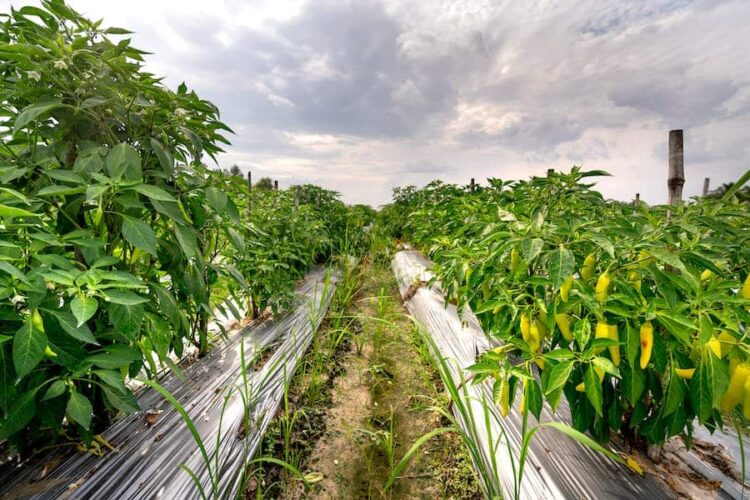Banana peppers, with their vibrant yellow hue and distinctive shape, have become a beloved ingredient in kitchens worldwide. Whether you’re a fan of sweet and tangy flavors or crave a hint of spiciness in your dishes, banana peppers offer a versatile and unique culinary experience. But the burning question remains: Are banana peppers hot? In this comprehensive guide, we’ll dive deep into the world of banana peppers, exploring their flavor profiles, spiciness levels, and the factors determining how much heat they pack. So, whether you’re a pepper enthusiast or simply curious about these delightful peppers, read on to uncover the truth about banana pepper spiciness.
Are Banana Peppers Hot?
Banana peppers are generally considered to be mild in terms of spiciness. On the Scoville Heat Scale, which measures the spiciness of chili peppers, banana peppers typically rank low, ranging from 0 to 500 Scoville Heat Units (SHU). This places them in the same heat category as bell peppers. While some banana peppers may have a slightly noticeable heat, most are prized for their sweet and tangy flavor rather than their spiciness. So, banana peppers are an excellent choice if you want to add a pop of color and a touch of mild heat to your dishes.
The Popularity Of Banana Peppers
The popularity of banana peppers has been steadily growing over the years, and they have become a widely recognized and beloved ingredient in various cuisines worldwide. Several factors contribute to their popularity:
Banana peppers are incredibly versatile and can be used in various dishes. They add a sweet, tangy flavor and a mild heat that complements savory and sweet recipes. You can find them in salads, sandwiches, pizzas, pickles, and toppings for various dishes.
Banana peppers are known for their mild spiciness. This makes them appealing to a broad audience, including those who enjoy a touch of heat without being overwhelmed by fiery flavors. Their Scoville Heat Units (SHU) typically range from 0 to 500, making them a safe choice for those with a lower tolerance for spiciness.
Banana peppers’ vibrant yellow color adds visual appeal to dishes. They are often used as a garnish to make plates more appealing, and their mild heat can provide a pleasant contrast to other ingredients.
Banana peppers are commonly pickled, which preserves them and enhances their flavor. Pickled banana peppers are a popular condiment in many households and are often used to elevate the taste of sandwiches, burgers, and salads.
Banana peppers offer various health benefits. They are a good source of vitamins and minerals, including C and B6. Additionally, they contain antioxidants that can support overall health.
Banana peppers are readily available in most grocery stores, making them accessible to home cooks and chefs alike. Their affordability and ease of use contribute to their popularity in both settings.
Different regions have incorporated banana peppers into their local cuisines, giving rise to unique dishes and flavor combinations. They are commonly used in Italian and Mediterranean cuisines.
As people become more adventurous in their culinary choices, banana peppers have gained recognition as a flavorful and versatile ingredient in contemporary cooking trends. Their use in fusion dishes and creative recipes continues to grow.
Factors Affecting Banana Pepper Heat
The heat level of banana peppers can vary, and several factors contribute to their spiciness. Understanding these factors can help you predict and control the heat when using banana peppers in your recipes. Here are the key factors affecting banana pepper heat:
Varietal Differences: Banana peppers encompass a wide range of varieties, each with its unique flavor and spiciness profile. The most common type, the sweet banana pepper, is known for its mild, slightly sweet taste. At the same time, other varieties, like the Hungarian Wax or the Hot Banana Pepper, are intentionally bred to be spicier. These differences are a result of selective breeding for specific flavor profiles.
Genetics: The genetic makeup of a banana pepper plant is a fundamental factor influencing its spiciness. Some plants naturally produce peppers with higher capsaicin content, the compound responsible for spiciness, while others are genetically predisposed to be milder. Plant breeders have developed cultivars with consistent heat levels for those who prefer predictability in their recipes.
Growing Conditions: Environmental factors during cultivation play a significant role in determining the heat of banana peppers. Factors such as soil composition, climate, and cultivation methods can impact their spiciness. Stressors like high temperatures, drought, or nutrient imbalances can cause the pepper plant to produce more capsaicin as a defense mechanism, resulting in hotter peppers.
Ripeness: The ripeness of a banana pepper at the time of harvest can dramatically affect its spiciness. Green, unripe banana peppers are generally milder, while fully ripe ones tend to be sweeter and potentially spicier. The heat level can increase as peppers mature, so growers and chefs often choose peppers at the desired stage of ripeness to achieve the intended flavor and spiciness in their dishes.
Drying: The drying process can intensify the spiciness of banana peppers. Allowing peppers to dry naturally on or off the plant can concentrate the capsaicin, making them spicier. Dried banana peppers often add a kick to various recipes, such as ground pepper flakes.
Cross-Pollination: Occasionally, cross-pollination can occur between different pepper varieties, leading to unpredictable spiciness levels in banana peppers. This phenomenon can happen when pepper plants of different varieties are grown nearby. To maintain consistency, growers may isolate pepper varieties to prevent cross-pollination.
Plant Stress: Banana pepper plants can respond to various stress factors by producing more capsaicin, which makes the peppers hotter. Water scarcity, nutrient deficiencies, and pest infestations may trigger this defense mechanism. Proper care and optimal growing conditions can help mitigate excessive spiciness due to plant stress.
Harvest Time: The timing of pepper harvest is crucial. Peppers harvested earlier in their growth cycle tend to be milder, while those left on the plant longer may develop more spiciness. When to harvest depends on the desired flavor and heat level for a specific recipe or culinary application.
Health Benefits Of Banana Peppers
Banana peppers offer a range of health benefits in addition to their delightful flavor. These peppers are a tasty addition to your meals and provide several nutritional advantages. Here are some of the health benefits of consuming banana peppers:
- Rich In Vitamins And Minerals: Banana peppers are a good source of essential vitamins and minerals. They are exceptionally high in vitamin C, known for its immune-boosting properties. Vitamin C also aids in collagen production, promoting healthy skin and wound healing. Additionally, banana peppers contain vitamin B6, which plays a role in brain development and function.
- Low In Calories: Banana peppers are low in calories, making them an excellent choice for those looking to manage their weight. They can add flavor and a satisfying meal crunch without significantly increasing caloric intake.
- Antioxidant Properties: These peppers contain antioxidants like beta-carotene and flavonoids, which help protect cells from damage caused by free radicals. Antioxidants may contribute to overall health and reduce the risk of chronic diseases.
- Digestive Health: Banana peppers’ fiber content aids digestion and can help prevent constipation. Consuming fiber-rich foods like banana peppers may promote a healthy digestive system.
- Blood Pressure Regulation: Banana peppers are a good source of potassium, a mineral that helps regulate blood pressure. Adequate potassium intake can counterbalance the effects of sodium, potentially reducing the risk of hypertension.
- Anti-Inflammatory Effects: Some compounds found in banana peppers may have anti-inflammatory properties. Consuming anti-inflammatory foods can be beneficial for those with conditions characterized by chronic inflammation.
- Boosted Immunity: Banana peppers’ high vitamin C content supports the immune system by promoting the production of white blood cells and enhancing immune response. A robust immune system can help the body defend against infections and illnesses.
- Pain Relief: Capsaicin, the compound responsible for the spiciness in banana peppers, has been linked to pain relief. Topical capsaicin creams are used to alleviate various types of pain, such as arthritis and neuropathic pain.
Culinary Uses Of Banana Peppers
Fresh in Salads:
When sliced or diced, Banana peppers make a refreshing addition to salads. Their mild spiciness and vibrant color can complement mixed greens, tomatoes, cucumbers, red onions, and more. They add a zesty kick to salads, enhancing their flavor.
Stuffed Banana Peppers:
Hollowed-out banana peppers are a delightful vessel for stuffing. A classic stuffing might include a mixture of breadcrumbs, cheese (such as feta or cream cheese), herbs, garlic, and sometimes ground meat. After stuffing, they can be baked until tender and served as an appetizer or side dish.
Pickled Banana Peppers:
Perhaps one of the most popular uses, pickled banana peppers are a staple condiment. They offer a tangy, mildly spicy kick and are often used to top sandwiches, burgers, hot dogs, and even pizza. Homemade pickled banana peppers can be customized with varying levels of spiciness and sweetness.
Pizza Topping:
Whether fresh or pickled, sliced banana peppers are a beloved pizza topping, they provide a burst of color and a tangy, slightly spicy flavor that complements the richness of cheese and other toppings. The combination of banana peppers with pepperoni, onions, and mushrooms is a classic favorite.
Sandwiches And Wraps:
Banana peppers can transform ordinary sandwiches and wraps into flavor-packed creations. Their zesty, spicy notes pair exceptionally well with deli meats, cheese, and various condiments. They add a layer of complexity to your handheld meals.
Salsa And Relish:
Chopped banana peppers can be crucial in making mild salsas or relishes. These condiments can enhance the flavor of grilled meats, seafood, tacos, burritos, and more. Their crunchy texture and tangy bite make them a versatile addition.
Ceviche:
In ceviche recipes, banana peppers can provide a tangy and slightly spicy element. Their crispness contrasts nicely with the tender seafood, creating a harmonious balance of textures and flavors.
Omelets And Scrambles:
Sautéed or diced banana peppers can elevate your breakfast game. They add a burst of flavor and a hint of heat to morning omelets, scrambled eggs, or breakfast burritos, making the start of your day more exciting.
Pasta And Rice Dishes: B
banana peppers can be stirred into pasta salads, rice dishes, and grain bowls, whether sliced or diced. They introduce a burst of flavor and color, working harmoniously with various ingredients and cuisines.
Garnish For Bloody Marys:
Banana pepper rings or spears make for an eye-catching and spicy garnish for Bloody Mary cocktails. Their visual appeal, combined with their zesty flavor, enhances the overall drinking experience.
Conclusion
The spiciness of banana peppers can vary, but they are generally considered mild, making them a versatile and accessible ingredient in various culinary creations. Whether you enjoy a subtle kick or prefer a sweeter flavor, banana peppers offer a delightful balance. Understanding their heat level, culinary uses, and health benefits allows you to appreciate these peppers and incorporate them into your cooking confidently. So, whether adding them to salads, pickling them for condiments, or exploring new recipes, banana peppers can bring a unique flavor and warmth to your dishes. Enjoy the culinary journey with these vibrant and flavorful peppers!
FAQ’s
Are Banana Peppers Hot?
Banana peppers are generally considered mild, although they can vary in spiciness. Most banana peppers have a Scoville Heat Unit (SHU) rating ranging from 0 to 500, which is relatively mild compared to other chili peppers.
How Do You Pickle Banana Peppers?
To pickle banana peppers, you can start by slicing or spearing them and then placing them in a mixture of vinegar, water, salt, sugar, and optional spices. Bring the mixture to a boil, pour it over the peppers in sterilized jars, and seal the jars for pickling.
How Do You Reduce The Heat Of Banana Peppers?
To reduce the heat of banana peppers, you can remove the seeds and membranes, as capsaicin, the compound responsible for spiciness, is concentrated in these parts. Deseeding and soaking the peppers in cold water can help mitigate their spiciness.







